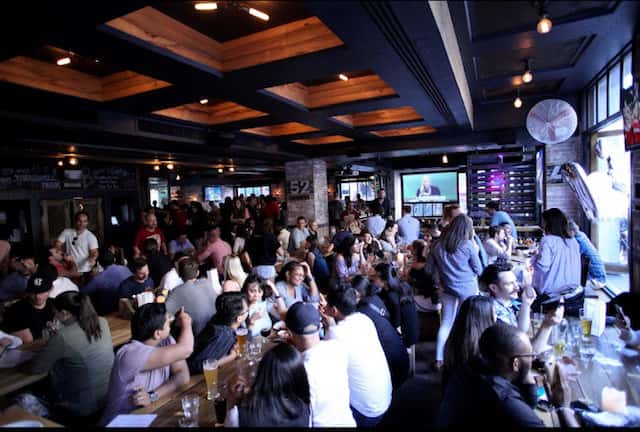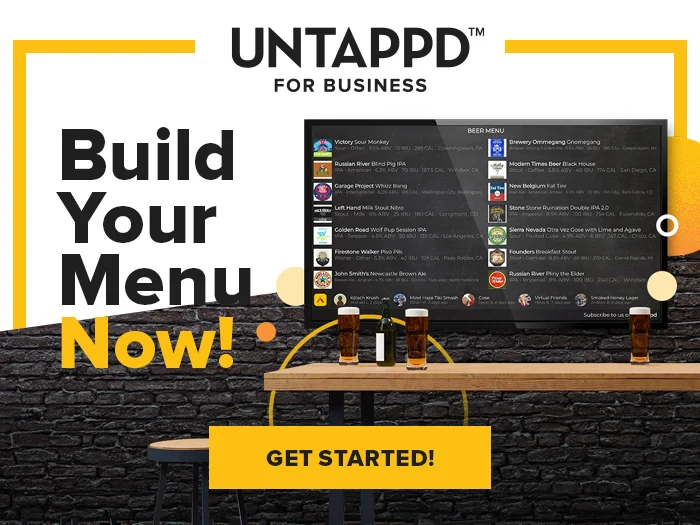
The Best 6 Happy Hour Ideas (2023)
UPDATED: 1/19/23
Two words: Increased revenue. That will continue to be the name of the game in 2023 as breweries, taprooms, bars, and restaurants have all returned to a “new normal” style of business and continue to deal with supply chain and economic challenges.
In the past, we’ve written about several strategies to help hospitality establishments generate increased revenue, including starting a mug club, the best bars games to attract patrons to your brewery, and the best ways to display QR codes. But another top tactic is to establish a happy hour, or to find more creative happy hour ideas.
Happy hours can be a simple strategy to attract new consumers, create loyal fans, and bring in more revenue during non-peak business times. They’re a win-win-win.
With that in mind, we put together a list of some of the top happy hour ideas to generate increased revenue, whether you’re considering the idea for the first time or you’re looking to bring some fresh post-COVID perspective to a tried and true tactic.
Gift Guide: 5 Holiday Stocking Stuffers for Brewers
Those batches of beer, like your brewers, are continuously in motion.
As the holidays approach and your staff continues to work hard to bottle and distribute those final batches of seasonal beers, it’s a good opportunity to thank them for making it all possible.
As the brewing season of 2023 approaches, help keep your brewers comfortable (and caffeinated) with some practical, brewer-friendly gifts.
Should Breweries Make Non-Alcoholic Beer?
A few years ago, a beer without alcohol in the United States seemed crazy. But today, non-alcoholic beer has become a growing trend in the U.S. So much so that many American craft breweries have taken a stab at making their own versions of non-alcoholic beer.
Beverage e-commerce site Drizly reported that NA category shares rose twenty-four percent on the platform year over year compared to the same period in 2021. More than one hundred non-alcoholic brands including beer, wine, cider, and spirits now live on Drizly, a seventy percent increase from last year. In the United States specifically, Statista reported that non-alcoholic brands contributed to over $414 million in sales.
While on a global scale, leading global alcohol industry market research firm IWSR reported in its IWSR Drinks Market Analysis that volume of no- or low-alcohol beverages grew by thirty-one percent year over year in 2022.
Basically, all signs point to non-alcoholic beer trending, if not growing into something more.
As a result, over the past few years, many craft breweries have added innovative, flavorful non-alcoholic beers to their portfolios. And entirely non-alcoholic beer brands are emerging in the market.
For instance, major established brands like Brooklyn Brewery, Boston Beer Co., and Dogfish Head have all crafted their own NA beers.
And solely non-alcoholic beer producers such as Athletic Brewing Co. are changing the status quo.
We predict this beer trend will continue to grow and that soon Americans will be drinking non-alcoholic beer all year round. So now the big question becomes: Is it worth your brewery investigating and investing in starting a non-alcoholic beer line?
The 5 Most Profitable Bar Foods
These days, serving food has become a core component of any drinking establishment. Adding a food menu to your bar or brewery creates a reason for people to stay and order more beers, increases your revenue, and brings more customers into your space.
And while the popularity of to-go meals increased during the pandemic, today, people are once again going out to eat in person at bars and breweries.
And when potential customers decide where to eat, the caliber of the meal takes precedence.
In fact, of the 2,600 diners questioned for a TouchBistro 2022 Diner Trends Report, sixty-eight percent agree that when deciding where to eat, food quality is the most important factor.
With food at the top of diners’ minds, bars and breweries, especially those just considering whether to serve food at all, should focus on developing a menu full of money-making foods to draw in those hungry customers.
Brewers Share Tips on Running Successful Hard Seltzer Brands
Earlier this year, we wondered if hard seltzer had lost some of its fizz. Turns out the bubble hasn’t popped yet. But the extreme growth of the category for the past three years has finally slowed down.
According to Drizly, for the first time in recent years, hard seltzer showed a seventeen percent year-over-year decrease during the 2022 Labor Day weekend. And during the summer, one of the busiest times of the year for pushing hard seltzer, Drizly reported sales dropping below last year’s Fourth of July numbers.
But despite the holiday slowdowns, the national eCommerce beverage platform did show that hard seltzer sales still have a 3.8 percent share in 2022, up from a 3.3 percent share of all sales in 2021.
While folks are still thirsty for hard seltzer, it has quickly become apparent that brands need to stand out on the shelf.
But how?
We spoke to several breweries, who have started their own craft hard seltzer brands over the past few years, to hear what has worked well for them, tips they have to share, and why you might not want to start a hard seltzer brand in today’s market.
How to Create a Prix Fixe Menu
The appreciation that people have for a delicious dinner is one thing that will never change.
In fact, Forbes reports that by the end of 2022, “the food service industry is expected to hit $898 billion in sales, a $99 billion increase over 2021 and a $220 billion increase over that unprecedented 2020.”
If you’re a restaurant owner looking to reassess your menu offerings in order to give customers their next extraordinary culinary experience, a prix fixe menu is one of the simplest and most successful strategies.
Let’s guide you through the ins and out of the prix fixe menu, how to build one, and what makes it profitable.
A Guide to a Standard Liquor Pour
There is nothing better than a full bar. As a bar owner, witnessing patrons sipping cocktails and engaging in conversation is a sign of repeat business and a profitable day.
According to a National Restaurant Association study, the typical bartender can make thirty-six drinks in an hour. To get the most out of your liquor bottles and maximize your margins on a busy night, it’s critical that your bartenders are well-versed in standard liquor pours.
We’re here to make sure your staff understands the standard liquor pouring techniques so they can consistently make the best-tasting cocktails for your customers.
What’s the Deal With No-Contact Delivery?
For the past few years, online ordering and delivery have become our new norm. Well, to be fair, consumers ordered food to their doorstep even before nationwide lockdowns started in early 2020, but the global pandemic greatly accelerated the trend. According to an article by McKinsey & Company, the global food delivery market is worth more than $150 billion, more than doubling during the COVID-19 pandemic.
In the four major markets where food delivery reigns supreme—Canada, Australia, the U.S, and the U.K.—the market has grown four to seven times larger than in 2018.
Since pandemic-related lockdowns started in March 2020, the growing food-delivery business has spiked to new heights in the most mature markets.

Graph courtesy of McKinsey & Company
At first, this was a contemporary shift for more traditional restaurants and eateries used to giving customer service in person. But by now, no-contact delivery has become the standard way to get food from your establishment to your customers’ homes.
Especially for those customers who are still cautious about venturing out to eat indoors or even those who just don’t want to get off the couch on a Saturday afternoon, they expect their food delivery to now come with the utmost care and safety in mind.
With that mind, it’s always good to review the ways you can maximize your contactless system, if you offer one. Or take a look at the best ways to set up no-contact delivery if it’s new to you.
Whether you’ve already implemented no-contact or contactless delivery or are finally considering it for the first time, here’s a guide on everything you need to know.
Should Your Business Stay Open on Thanksgiving and Black Friday?
As consumers, Thanksgiving usually means two extra days off of work to spend time with family and friends celebrating an American holiday. For brewery, bar, and restaurant owners, however, the prospect of a federal holiday like Thanksgiving poses an interesting question: Should you stay open?
Traditionally, Thanksgiving and the subsequent day dubbed Black Friday have been the days when Americans spend…and spend big.
According to the National Retail Federation (NRF), the world’s largest retail trade association, during the 2021 holiday season, Black Friday brought in a whopping 66.5 million people shopping at stores with the average adult spending $430 dollars (Deloitte).
And while these have traditionally meant big and small retailers, Goose Island is probably the brewery most well known for getting beer businesses in on the Black Friday action. Since 2010, the brewery has released its incredibly popular barrel-aged Bourbon County Brand Stout and its yearly variants the morning of Black Friday. It’s a special event that has become a bit of tradition with folks lining up around the block to get their hands on a limited number of that year’s bottles.
And other breweries have since followed suit with everyone from Weldworks to Lakefront Brewery to 3 Sons getting in on the action.
But increasingly on a wider scale, more retailers have actually closed their doors on Turkey Day and subsequent Black Friday. In 2020, major chains such as Walmart, Best Buy, and Dick’s Sporting Goods closed on Thanksgiving for the first time and continued that trend in 2021. Similarly, last year, Target took things a step further, announcing that it will close all of its stores on Thanksgiving every year for the foreseeable future.
It’s a bit of a quandary: stay open and potentially tap into one of the largest sales days in America, or close and give yourself and your staff time off to spend with their families?
Keeping a restaurant or similar establishment open during a federal holiday means understanding a few considerations. For example, recognizing that overtime requirements can mean you might need to pay your employees more than the average weekday. Consequently, staying open might only be profitable if you can ensure that you’ll experience increased traffic that day.
Overall, what are the advantages of keeping your bar, brewery, or restaurant open on Thanksgiving and/or Black Friday? Alternatively, what are the potential benefits of choosing to give your staff the day off? And if you do decide to light up that open sign, how can you prepare?
We weighed both sides of the equation and offered a few tips and tricks on how to navigate that question during this holiday season.
Should You Start a Food Delivery Service?
Forbes called it.
While researching food industry trends for 2022, they forecasted that the pandemic would drive a revolution in digital and delivery services by changing how people purchased and received food like curbside pickup, online ordering, and delivery.
Now, it’s a sentiment shared across the industry. Boston Consulting Group reported in the article “The $100 Billion Digital Lifeline for Restaurants” that “Delivery’s market share jumped from 7% in 2019 to about 20% in 2020. Across the industry, digital ordering now represents 28% of all orders compared with 10% before the pandemic, with most brands showing increases.”
As customers continue to order their food online, it’s time for breweries, bars, and restaurants to consider food delivery services (if you haven’t already). Should you develop your own delivery system for your restaurant or lean into a third-party alternative?
We’re breaking down the advantages, disadvantages, and potential revenue streams that a food delivery app can provide to help you consider all your options.
